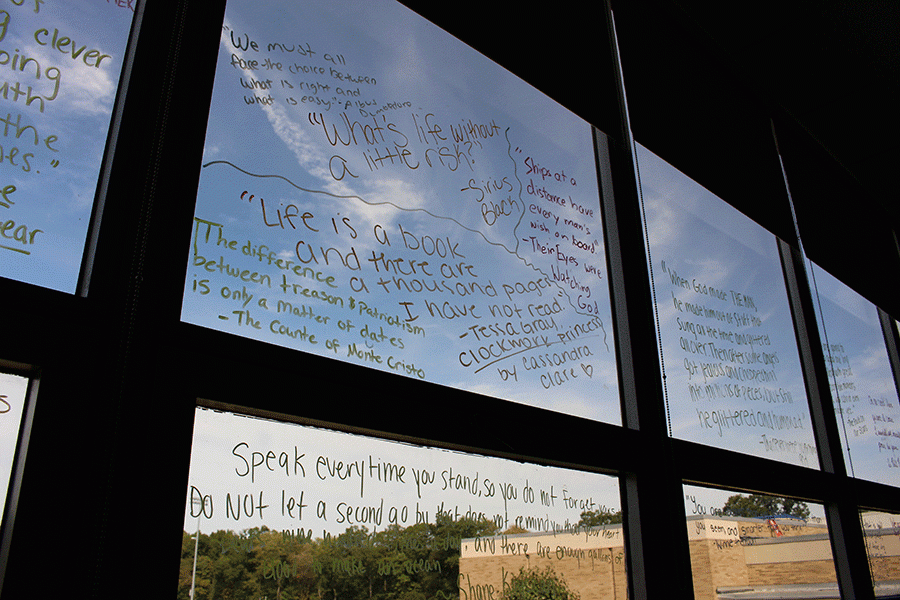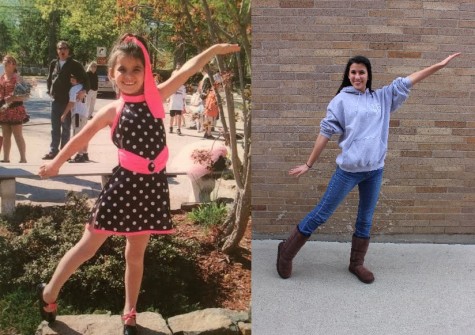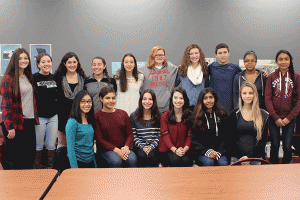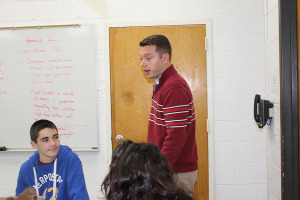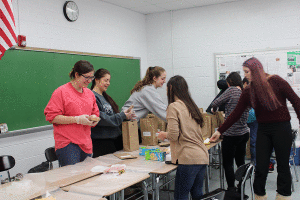Sophomore English teacher reinvents class curriculum
Mr. Morone has changed his curriculum to give more freedom to his students. He encourages creativity in many forms, and one of which is by writing quotes on the windows.
The concept of an “open classroom” is nothing short of unique.
Mr. Matthew Morone, an Honors English teacher here at Pascack Valley, has created some massive changes to his curriculum this year.
Over the summer of 2015, Morone reinvented the standard sophomore English curriculum in such a way that, he believes, plays a larger role in the life ahead of his students.
He has sacrificed his role of standing in front of the classroom as the instructor in order to give his students individual freedom.
“In a nutshell, students, in the beginning of the year, are presented with the entire curriculum. Students are given a sheet called a Mastery Card which lists all the different standards that they are expected to cover over the course of the year,” Morone said. “The student individually, or with a small group, can move through the curriculum at their own pace by setting their own deadlines.”
The term “open classroom” is relevant because by issuing out Mastery Cards, the students can collaborate with different people and work on whatever they want in any manner or at any time that they want.
For example, if a student wants to read “Catcher in the Rye” they have to demonstrate that they understand the novel by addressing certain applicable standards on their card such as a presentation or a recorded discussion.
Sometimes, students can even knock out multiple standards at once. For example, a student could write an essay that addresses all of the applicable Narrative and the Writing standards, such as introduction of characters, use of sensory details, MLA formatting, and parallel structure, to name a few.
Instead of given a letter grade, they are given either N, A, P, or M. These stand for Not Yet Proficient, Approaching Proficiency, Proficient, and Mastery. By the end of the year, every student must be Proficient in every standard. Mastery can be achieved if that student assists another student on a topic in which they are proficient in.
Through Canvas, students can see a percentage of the work that they already have completed throughout the year in comparison to the amount of work that must be completed by the time that the year is over. Their goal is to keep that percentage within the range of the majority of the class so that they don’t fall behind.
“I found that in the past, when I teach in front of a whole group of kids, there are some that pay attention; we like to pretend, at least I would, that everyone is listening, but they aren’t always listening. With this (new teaching method), I can actually talk to all my students during the course of the period which I could never do in the past,” Morone said.
If a student needs help with anything, from catching up with the majority of the class to revising an essay, they can schedule a conference with Morone. If you were to walk into his classroom, you would most likely observe Morone walking around speaking with different students; this is a rare luxury, according to him, under normal teaching scenarios.
Late last year, Morone realized that the best work being submitted by the students was the work in which they had the most choice.
In order to recreate his curriculum, Morone had to take a step back and look at the bigger picture. “Did I believe in those things in my practice or was I doing them just because I thought that I was supposed to? If I had complete say, what would my classroom look like?” Morone said.
He got to a point in which he had to step out of the box considered to be “the teacher norm” and reinvent what has been practiced for centuries.
He spent his entire summer creating a system in which the students don’t have to face the board every morning when they walk in and listen to the instructor teach. Rather, Morone has created a system in which students have the freedom to accomplish what they want when they want, a smaller replica of life after high school, and use such freedom as a vessel for the practice of creativity in their work.
“I think that it is something that I’m very passionate about. I’m going to continue to pursue the philosophies behind this,” Morone said. “It will most likely look similar to the way it is now and hopefully it will be more effective in the years to come.”
” background=”on” border=”all” shadow=”on”]

